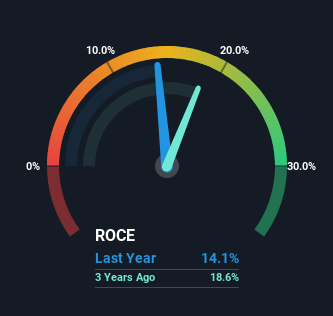- India
- /
- Consumer Durables
- /
- NSEI:DENEERS
De Neers Tools (NSE:DENEERS) Might Be Having Difficulty Using Its Capital Effectively
Finding a business that has the potential to grow substantially is not easy, but it is possible if we look at a few key financial metrics. In a perfect world, we'd like to see a company investing more capital into its business and ideally the returns earned from that capital are also increasing. Put simply, these types of businesses are compounding machines, meaning they are continually reinvesting their earnings at ever-higher rates of return. However, after briefly looking over the numbers, we don't think De Neers Tools (NSE:DENEERS) has the makings of a multi-bagger going forward, but let's have a look at why that may be.
Return On Capital Employed (ROCE): What Is It?
If you haven't worked with ROCE before, it measures the 'return' (pre-tax profit) a company generates from capital employed in its business. The formula for this calculation on De Neers Tools is:
Return on Capital Employed = Earnings Before Interest and Tax (EBIT) ÷ (Total Assets - Current Liabilities)
0.14 = ₹138m ÷ (₹1.4b - ₹448m) (Based on the trailing twelve months to March 2024).
Therefore, De Neers Tools has an ROCE of 14%. That's a relatively normal return on capital, and it's around the 12% generated by the Consumer Durables industry.
View our latest analysis for De Neers Tools

Historical performance is a great place to start when researching a stock so above you can see the gauge for De Neers Tools' ROCE against it's prior returns. If you're interested in investigating De Neers Tools' past further, check out this free graph covering De Neers Tools' past earnings, revenue and cash flow.
What Can We Tell From De Neers Tools' ROCE Trend?
On the surface, the trend of ROCE at De Neers Tools doesn't inspire confidence. Over the last four years, returns on capital have decreased to 14% from 18% four years ago. However, given capital employed and revenue have both increased it appears that the business is currently pursuing growth, at the consequence of short term returns. If these investments prove successful, this can bode very well for long term stock performance.
On a related note, De Neers Tools has decreased its current liabilities to 31% of total assets. So we could link some of this to the decrease in ROCE. Effectively this means their suppliers or short-term creditors are funding less of the business, which reduces some elements of risk. Since the business is basically funding more of its operations with it's own money, you could argue this has made the business less efficient at generating ROCE.
Our Take On De Neers Tools' ROCE
Even though returns on capital have fallen in the short term, we find it promising that revenue and capital employed have both increased for De Neers Tools. And there could be an opportunity here if other metrics look good too, because the stock has declined 15% in the last year. As a result, we'd recommend researching this stock further to uncover what other fundamentals of the business can show us.
One more thing: We've identified 3 warning signs with De Neers Tools (at least 2 which don't sit too well with us) , and understanding them would certainly be useful.
While De Neers Tools isn't earning the highest return, check out this free list of companies that are earning high returns on equity with solid balance sheets.
New: Manage All Your Stock Portfolios in One Place
We've created the ultimate portfolio companion for stock investors, and it's free.
• Connect an unlimited number of Portfolios and see your total in one currency
• Be alerted to new Warning Signs or Risks via email or mobile
• Track the Fair Value of your stocks
Have feedback on this article? Concerned about the content? Get in touch with us directly. Alternatively, email editorial-team (at) simplywallst.com.
This article by Simply Wall St is general in nature. We provide commentary based on historical data and analyst forecasts only using an unbiased methodology and our articles are not intended to be financial advice. It does not constitute a recommendation to buy or sell any stock, and does not take account of your objectives, or your financial situation. We aim to bring you long-term focused analysis driven by fundamental data. Note that our analysis may not factor in the latest price-sensitive company announcements or qualitative material. Simply Wall St has no position in any stocks mentioned.
About NSEI:DENEERS
Adequate balance sheet with acceptable track record.
Market Insights
Community Narratives


Recently Updated Narratives


Alphabet: The Under-appreciated Compounder Hiding in Plain Sight


MINISO's fair value is projected at 26.69 with an anticipated PE ratio shift of 20x


The Quiet Giant That Became AI’s Power Grid
Popular Narratives


The company that turned a verb into a global necessity and basically runs the modern internet, digital ads, smartphones, maps, and AI.


MicroVision will explode future revenue by 380.37% with a vision towards success



